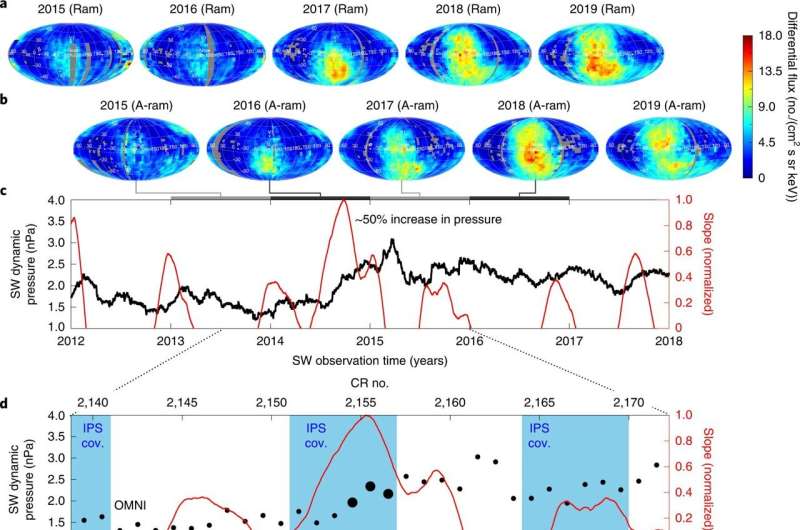IBEX ENA fluxes and SW properties. a,b, IBEX ENA sky maps are shown for roughly 3–6 keV ENA fluxes. a, Ram maps correspond to times when observations are made in the spacecraft ram frame. b, Antiram (A-ram) maps are observations made in the antiram frame. Pixels in corresponding years between rows a and b are offset by 6 months. IBEX observations are corrected for the Compton–Getting effect when transforming from the spacecraft frame to the solar inertial frame and corrected for ENA losses between 100 and 1 au. c, SW dynamic pressure observed by ACE and Wind at 1 au in the ecliptic plane (black), smoothed over two CRs. Approximate time delays between SW and ENA observations are illustrated by the coloured grey bars. The running linear slope fit to SW pressure over ±3 CRs is shown in red. d, IPS observations cover the three CRs nearest to the peak change in SW dynamic pressure (CR 2,154–2,156, large black dots), centred on 2014.75. e, IPS-derived SW speeds as a function of heliolatitude during CR 2,154–2,156. Speeds are shifted uniformly to match OMNI at low latitudes during each CR (OMNI, coloured points). We use SW observations weight averaged over this period (black curve) to analyse IBEX observations. The grey contour represents the propagated standard deviation of the average. f, A large coronal hole in the southern hemisphere, visible in SDO/AIA observations as the dark colour spot, resulted in fast SW at mid-latitudes in CR 2,156 (image courtesy of NASA/SDO and the AIA science team). Credit: Nature Astronomy (2022). DOI: 10.1038/s41550-022-01798-6
A team of researchers with members from Princeton University, the University of Texas at San Antonio, the University of Waikato, Los Alamos National Laboratory and the Southwest Research Institute has discovered rippled structures in the part of space at the boundary of the solar system. In their paper published in the journal Nature Astronomy, the group describes analyzing data from Voyagers 1 and 2 and also from NASA's Interstellar Boundary Explorer (IBEX), which circles the Earth, to learn more about the nature of space at the boundary of the solar system.
Prior research has shown that, at the edges of the solar system, there is a point at which the solar wind slows to a speed at which sound can travel—it is called the termination shock. Prior research has also shown that there exists a point where the solar wind becomes incapable of pushing back against pressure exerted by interstellar space—it is called the heliopause. Both of the Voyager space probes have pushed through this boundary and into interstellar space. And as they did so, they sent back sensor data. Also, NASA launched IBEX into orbit back in 2009—its purpose is to study the characteristics of the boundaries of the solar system.
By analyzing data from all three sources, the researchers noted a sudden change in pressure exerted by the solar wind in 2014, and used the relatively short time scale of the event to study the shape of the heliopause and termination shock. They were able to measure the energized neutral atoms that came about when the solar wind was colliding with the interstellar wind.
Since some of the atoms managed to escape into interstellar space and others were bounced back into the solar system, the researchers were able to use the data as a form of cosmic echolocation. When modeled, the researchers found that huge ripples were formed in the boundary areas. They also found major shifts in the distance to the heliopause, suggesting that its shape was not uniform and that it was continually changing for unknown reasons.
The researchers hope to learn more about the boundary of the solar system using data sent back to Earth from a new probe set to launch in 2025—it will be capable of sending back measurements of neutral atom emissions with higher precision.
More information: Eric J. Zirnstein et al, Oblique and rippled heliosphere structures from the Interstellar Boundary Explorer, Nature Astronomy (2022). DOI: 10.1038/s41550-022-01798-6
Journal information: Nature Astronomy
© 2022 Science X Network
























